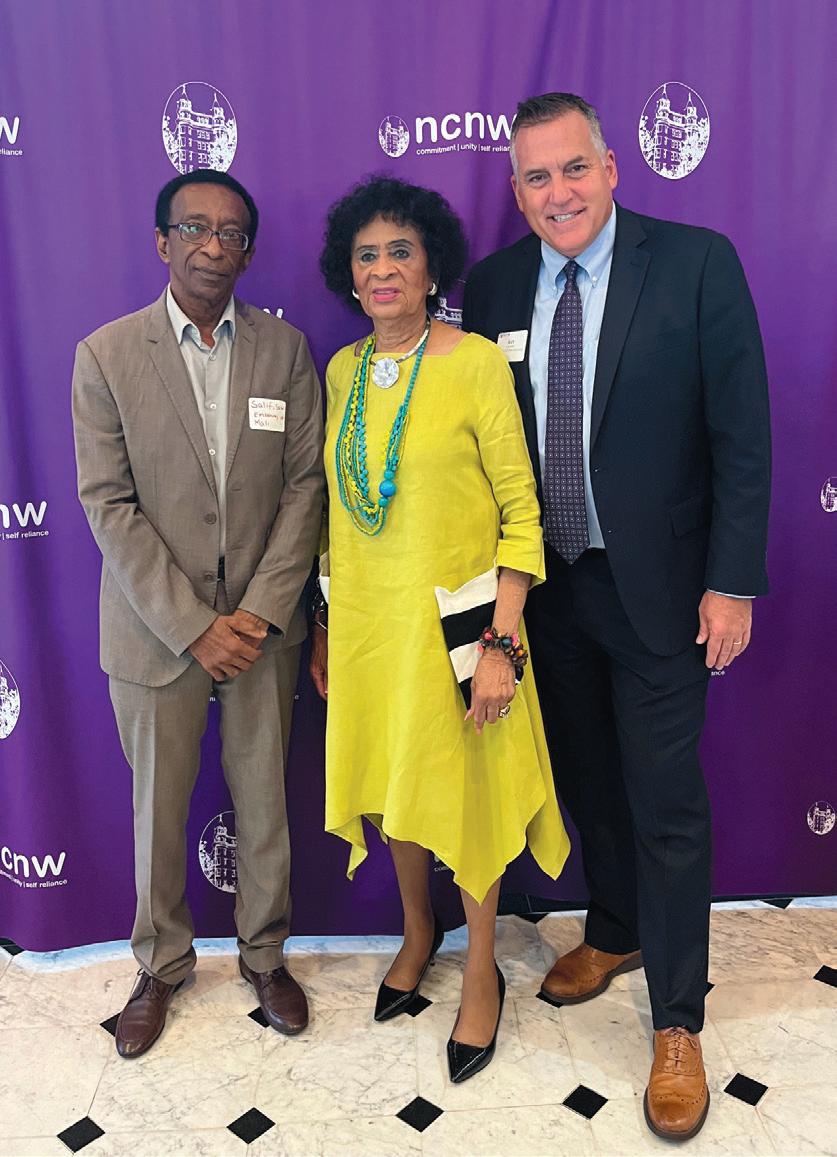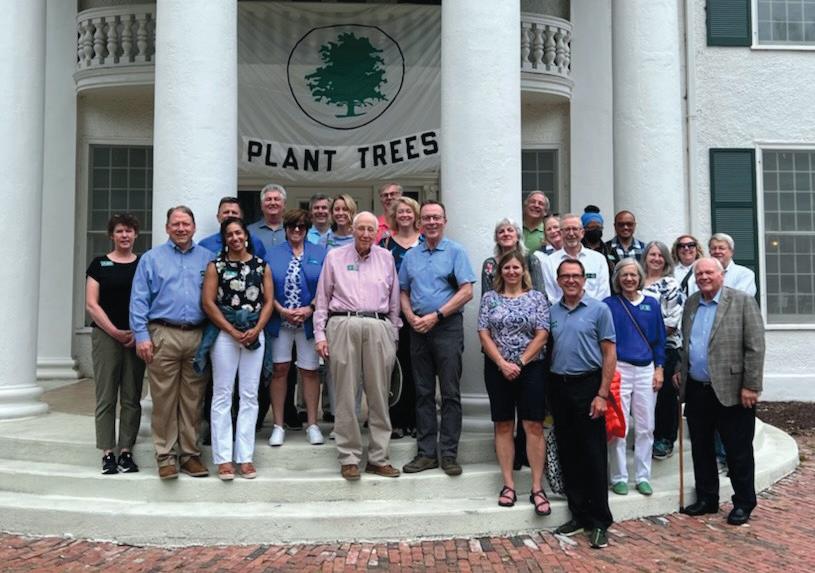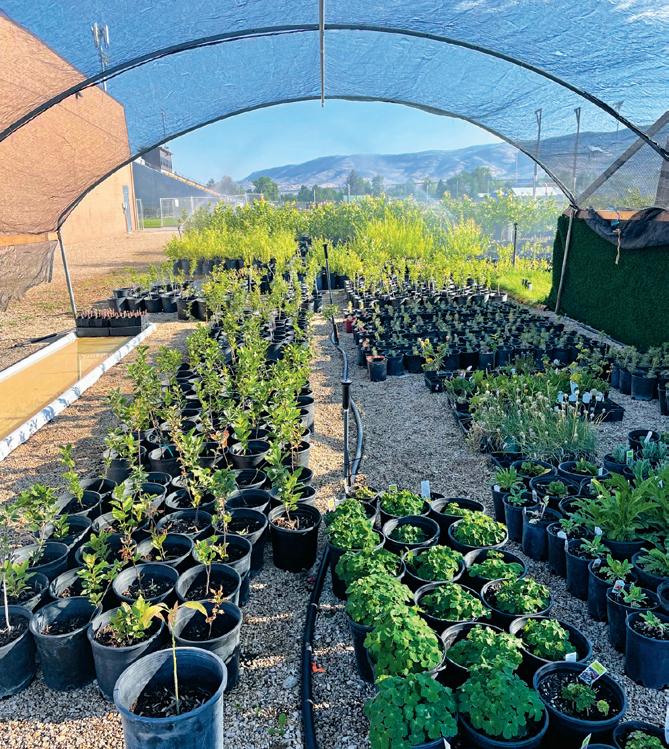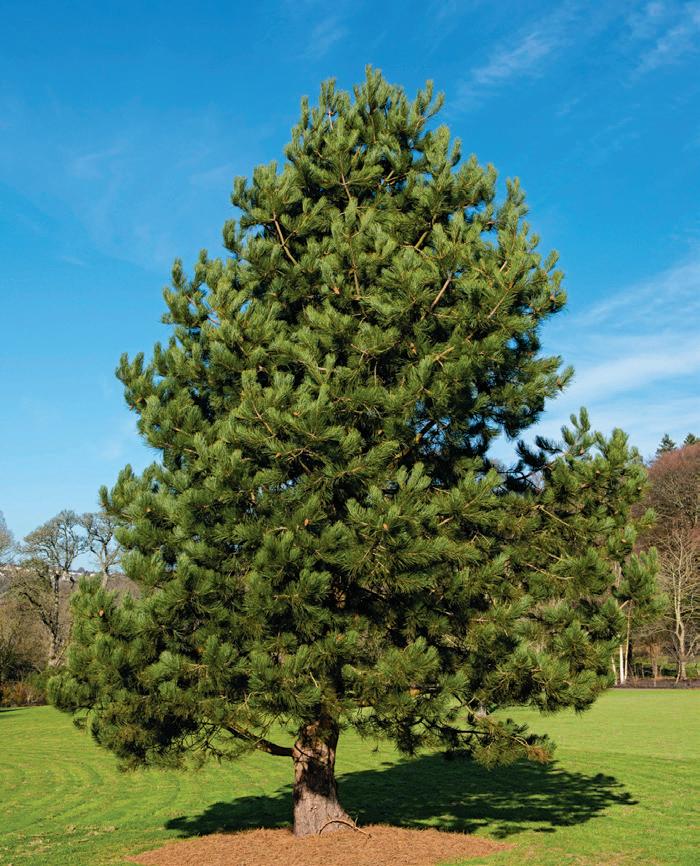
NOVEMBER/DECEMBER 2022 • ARBORDAY.ORG
INSPIRING THE NEXT GENERATION OF TREE PLANTERS THROUGH A DEEPER LEVEL OF ENGAGEMENT
ARBOR DAY FOUNDATION CHIEF EXECUTIVE, Dan Lambe

ARBOR DAY JOURNAL
LIKE MANY OF YOU, my connection to trees began in childhood. I think back with fondness to the massive pin oak that stood right outside my family’s front door. It was a beautiful tree with branches that seemed to reach out forever. This was the kind of tree that served as the backdrop of our lives, showing up in hundreds of family photos and constantly woven in the fabric of cherished memories from long ago.
I may not have always appreciated all that tree did for me — shading our home, filtering pollutants out of the air, capturing rainwater, nurturing wildlife — but I knew it mattered. And I bet if you think about your younger years, you will have similar memories of a tree in your neighborhood.
As far as my passion for planting trees, that all started with my parents. They instilled in me the importance of greening our world as we planted hundreds of trees together. Without these experiences in my youth, I would not be the passionate tree planting advocate I am today.
That’s why I’m excited about the inaugural year of the Tree Campus K–12 program. We are recognizing schools across the country that are going beyond the basic classroom curriculum to engage students in the natural world. They are planting trees, learning proper tree care and maintenance, and celebrating Arbor Day. But it’s so much more than that. They are embracing the importance of these trees in a tangible way. And they are excited about how their work benefits their communities for decades to come.
Just as my parents nurtured my passion for trees, teachers across America are doing the same for their students. Congratulations to the 67 schools recognized this year!
The Healing Power of Green Space
OVER THE YEARS, a growing body of research has proven what many nature lovers already know — spending time outside has some amazing health benefits.
Access to green space has been linked to better sleep, reduced depression and stress, improved recovery from surgery, and more positive outcomes for cancer patients.
Hospitals and long-term care facilities across the country are joining this public health movement by prioritizing their trees and green space. And they’re being celebrated for their efforts through the Arbor Day Foundation’s Tree Campus® Healthcare program.


30 Facilities and Counting
Tree Campus Healthcare facilities must meet a core set of standards to earn recognition. They include: having a facility tree care plan, completing a community forestry project, maintaining an advisory committee for tree-related decisions, hosting an annual celebratory event, and investing $2 per employee for campus trees.
The program kicked off in 2019 with 16 recognized facilities. Today, more than 31 facilities nationwide have earned this special status.
IU Health Bloomington 1st Year Recognized
IU Health Bloomington at the Indiana University Regional Academic Health Center, which opened its doors in 2021, is a shining example of prioritizing nature in healthcare settings.
The hospital grounds are filled with green nearly everywhere you turn, with countless trees, walking trails, and a healing garden. Large windows allow patients and staff to soak up these views from the inside. Its entrance also includes an art display called “Shades of Southern Indiana,” with nature-inspired pieces commissioned by local artists.
The multi-level healing garden at IU Health Bloomington.

On each of the past two Arbor Days, hospital staff have celebrated by planting a tree together.
arborday.org
On the cover: The Tree Campus® K–12 program works to engage elementary, middle, and high school students in the importance of trees. Planting activities are often part of earning school recognition.
2 ARBOR DAY • November/December 2022 • 888-448-7337 •
FOLLOW US
AT
facebook.com/arborday
Courtesy: Indiana University Health
Providing Relief in Food Deserts

MORE THAN 23 MILLION AMERICANS live in “food deserts,” or neighborhoods with limited access to fresh and healthy food. Grocery stores in these areas tend to be miles away — a lengthy trek for those without a car or reliable transportation. The end result is that it is often easier, and more affordable, to get meals from a convenience store or fast-food restaurant.
Community food forests are a natural solution to this problem. Often funded by grants and established by a mix of volunteers and local residents, these garden spaces provide fresh fruits and vegetables to surrounding residents.
What exactly grows in a food forest depends on the hardiness zone and growing conditions, but the University of Minnesota Extension office provides some insight into their basic structure:
A food forest is typically comprised of three to seven layers, which allow a small space to be used at multiple levels.
• The uppermost layer, or overstory, contains larger food-producing trees.
• The understory contains small trees and shrubs.
• The floor is home to herbaceous plants, root crops, ground cover crops, and vines.
For example, a three-layer system might include apple and cherry trees, hazelnut and Juneberry shrubs, and herbaceous plants such as asparagus and rhubarb.
Find more tips on how to start your own community garden at arborday.org/foodforest
GIVE GIFTS that Give Back

Have you started making your holiday shopping list? If so, consider purchasing gifts for friends and family from the Arbor Day Foundation! Each item from our store plants a tree in a forest in need — and engages your loved ones in the important mission of environmental stewardship. Shop today at arborday.org/holiday.

A Success Story in Atlanta
In the Browns Mill neighborhood of Atlanta, one-third of residents live in poverty. A trip to the supermarket involves a 30-minute bus ride.
Six years ago, the city established a 7-acre food forest in the area. The garden has 2,500 edible and medicinal plants that are grown free from chemicals. It’s managed by the Atlanta’s Parks and Recreation Department and cared for by more than 1,000 volunteers. And, best of all, it is used as a learning tool and connection point for the entire community.
ARBOR DAY • November/December 2022 • 888-448-7337 • arborday.org 7
Trees of Hope
Partnering with the National Council of Negro Women to plant a better tomorrow
WHEN THE DRIVING GOALS of two nonprofit organizations align, great things happen. This is the case with the Arbor Day Foundation and the National Council of Negro Women (NCNW). Together, we are working to plant up to 100,000 trees in Haiti, Mali, and Senegal through NCNW’s Trees of Hope campaign.

Reforestation efforts are needed in Haiti’s southern mangroves and coastal marshes to help stabilize shorelines and improve the health of local reef ecosystems. By working with local farmers in Mali and Senegal, tree planting efforts can help solve issues such as deforestation, hunger, and poverty.
“We know that trees support the environment and protect the coasts against soil erosion. They provide food, shade, building material, aesthetic appeal, and economic opportunity,” said Dr. Thelma Daley, NCNW Chair of the Board and 8th National President. “Trees of Hope is born out of NCNW’s tradition of respect for our shared interconnected global responsibility for the future of Mother Earth.”
The world needs trees now more than ever, and this partnership is helping to fulfill that need where it is greatest.
From left, Sadifi Sow, Counselor to the Mali Embassy; Dr. Thelma Daley; and Dan Lambe, Arbor Day Foundation chief executive, at the launch of the Trees of Hope campaign.
Charitable Gift Annuities —
A Priceless Legacy
TREES THRIVE FOR GENERATIONS, and so can your support of the Arbor Day Foundation with the help of a Charitable Gift Annuity. As you receive consistent retirement income, you’ll feel good knowing your gift will also leave a legacy for years to come.

Charitable Gift Annuities offer retirement income, with a large portion of it being tax-free. For example, Patricia, age 84, made a $75,000 donation to the Arbor Day Foundation through a Charitable Gift Annuity. She receives $5,550 (7.4%) annually, with $4,739 of it tax-free. Additionally, at tax time, she can take a $40,392 charitable deduction that can be spread over several years, if necessary.
When Patricia passes away, the remaining funds in the annuity will be distributed to the Foundation. This gift will not only support tree planting efforts but also ensure that Patricia’s passion for trees will live on.
To receive additional information and a confidential quote on a Charitable Gift Annuity, please complete and mail the form at left, contact Erin Mousel at 888-448-7337, ext. 9614, or email giftplanning@arborday.org.
* The illustration above is an example; exact numbers are subject to change based on date of gift.

LEARN MORE. NO OBLIGATION. Mail to: Arbor Day Foundation 211 N. 12th St. • Lincoln, NE 68508 Please provide me with a confidential quote for an Arbor Day Foundation Charitable Gift Annuity. Birth Date / / I am considering a gift annuity of $ ($10,000 minimum) Name Address City/State/Zip Telephone ( ) Best time to call Email 08718 100
Coming Full Circle
Morton Arboretum trustees pay special visit to Arbor Day Farm
OVER THE YEARS, Arbor Day Farm has served as the backdrop for countless memorable events.

This past summer was no exception.
In June, trustees from the Morton Arboretum held a board meeting at the farm in celebration of their 100th anniversary. The Chicago-area botanical garden was founded in 1922 by none other than Joy Morton — the eldest son of J. Sterling Morton, the founder of Arbor Day.
Deep-Rooted History
Joy Morton was born in Detroit in 1855. He then moved with his family to Nebraska City, where he grew up surrounded by nature on the Arbor Day Farm property.
Eventually, Joy became a successful industrialist as head of the Morton Salt company in Chicago. And his love of trees endured. He bought land and built a large country estate 25 miles west of the city in Lisle, Illinois, where he lived for many years.
In 1922, following in his father’s footsteps, Joy donated the land surrounding his estate to the public. The area was to serve as “a great outdoor museum” of trees for research, education, and enjoyment. It was named the Morton Arboretum.
Today, the Morton Arboretum is one of the world’s most influential botanical organizations, with 1,700 acres of natural beauty and 1 million annual visitors.
Though Joy passed away in 1934, his family’s motto — “Plant Trees” — lives on in both of these beautiful properties.
A Meaningful Perspective
Many of the trustees had never visited the Arbor Day Farm property before this summer. The trip served as a full-circle moment, connecting them to the origins of their beloved organization.
Morton Arboretum trustees and staff are pictured outside of Arbor Lodge, where their founder, Joy Morton, grew up as a child.
It was also the perfect way to celebrate a trio of milestone anniversaries coinciding in 2022 — 150 years of Arbor Day, 100 years of the Morton Arboretum, and 50 years of the Arbor Day Foundation.
Their visit included a stay at Lied Lodge, a reception at the Apple House Market and dinner at the Historic Barns, a program about the property’s hazelnuts and apple orchards, and tours of the Arbor Lodge mansion (the home in which Joy Morton lived).
Arbor Day Foundation chief executive Dan Lambe met with the board and spoke about the shared heritage and mission of the two organizations.
To top it all off, the board planted a commemorative tree — Centennial™ linden — on the grounds.
It was an honor to host this group and see our joint tree planting legacy at work.

ARBOR DAY • November/December 2022 • 888-448-7337 • arborday.org 3 FOR RESERVATIONS TO STAY AT LIED LODGE: arbordayfarm.org • 800-546-5433 Nebraska City, Nebraska
NATURE TAKING ROOT
Inspiring a passion for trees through Tree Campus® K–12


After we developed and piloted an exciting new program focused on engaging elementary, middle, and high school students in nature, the COVID-19 pandemic halted the nationwide launch of Tree Campus K–12 recognition. Two years later, the Arbor Day Foundation is excited to announce that 67 schools were recognized in this inaugural year of the program.
To receive recognition, these schools needed to fulfill the requirements of four goals:

1. Tree Campus Team
Education Plan
Hands-On Experience
4. Arbor Day Observance
Even though each school was working toward the same set of goals, the ways in which they met them were unique. It was enjoyable to read story after story of teachers and students experiencing the wonders of trees together — whether in the classroom or out in nature.

Big Ideas in Action
One school that has really embraced the idea of engaging students in nature (even before the launch of this program) is Wasatch High School in Heber, Utah. As the community grew, the high school expanded to a second building that once served as the middle school. That meant the space between the buildings — formerly a basketball court, playground, etc., for younger students — needed a new purpose.
What the grounds manager saw as a problem (because, well, the grass just would not grow) was actually a golden opportunity in the eyes of teacher
4 ARBOR DAY • November/December 2022 • 888-448-7337 • arborday.org
2.
3.
The students at Wasatch High School not only maintain a tree nursery and vegetable garden but also support the community through tree planting.
Matthew Zierenberg. As the FFA advisor and instructor of environmental agriculture for the school’s Center for Advanced Professional Studies, Matthew knew they could use the space as an outdoor classroom and entrepreneurial space for students.
Over the course of three years, the approximately 1-acre area became home to an orchard, aquaponics greenhouse, tree nursery, and barn. That’s right, the students brought a farm to life right at the school. It’s called IDEAL Farms, and it provides an opportunity for them to not only learn as they care for the land and animals but also gain experience operating a business.
“Every square inch is used in some way,” said Matthew. “We have a pavilion, which is my outdoor classroom. It was an old concrete slab, and we just threw a carport on it right against the building. Now I have a whiteboard on that wall, and I can take kids out to teach at the farm.”
Engaging with the Trees
One core part of IDEAL Farms is the tree nursery. Students grow native, drought-tolerant trees and shrubs onsite and then sell them to local homeowners to plant in their yards.


Because having regular nursery hours would be difficult, the class created a self-serve tree store. The trees are put out on the corner with informational signs and QR codes to make online payment simple. People in the community can then shop for trees at their own convenience. Part of the earnings from these purchases are put toward wages for teens who work on the farm throughout the summer, and the rest of the money is then set aside as scholarship dollars for them once they graduate.
And as much as the community is supporting the students’ hard work, the students are supporting the community as well. They have participated in multiple tree plantings in wildlife management areas and along riverbanks, using trees and shrubs from the school nursery. “We filled up the back end of the school bus to haul the trees down to this wildlife management area. And it’s funny, I thought that the school bus driver was going to be just appalled that we were doing this. And I thought the bus director or transportation director was going to be appalled. And they’re like, ‘This is the best use of a bus ever!’ We got the leaf blower and blew out the bus really quick afterwards.”
Planting and Caring for the Future
Throughout the school year, students have many opportunities to expand their knowledge about
planting and caring for trees outside of the nursery. They have been mulching, pruning, and generally caring for the trees in the orchard and all across the school’s property.
And Matthew has enjoyed helping them learn even the simplest things, like how to dig a hole. “I never thought I would have to teach a kid how to use a shovel, but this 16-year-old boy had no clue how to use the shovel and step on the back edge with his foot. He goes, ‘Oh, that’s what that little bump’s for?’ I mean, I never thought I’d have to teach that. But all of a sudden, they’re really engaged. They’re interested.”
This is just one of the many amazing stories from the first year of the Tree Campus K–12 program. As this program grows, it will mean more tree planters for generations to come. Learn more about how this program is engaging youth across the U.S. at arborday.org/k12. n
An Emphasis on Partnerships
One thing Matthew emphasizes is the importance of support from community partners. “Having the mentors and having support from the community and having people saying, ‘Hey, this is a good idea. Let’s keep pushing!’ has made all the difference.” Their journey has been supported by Spring Creek Conservation (a local nursery whose staff served as a mentor for the students), Utah Forest Fire and Lands, Sportsman’s for Fish and Wildlife, and Wasatch County Parks and Recreation.
ARBOR DAY • November/December 2022 • 888-448-7337 • arborday.org 5
Wasatch High School’s IDEAL Farms is tucked into a 1-acre space right on campus, making it easy to engage students.
Austrian Pine

Pinus nigra
THE AUSTRIAN PINE is known for its superior resistance to wind and soil erosion. In fact, during the Dust Bowl era, more than 200 million of these trees were planted in shelterbelts across the United States.
Other winning qualities of this evergreen include its tolerance to drought, pollution, and salt spray. It’s beautiful year-round — and offers fantastic privacy in urban settings.
NEEDLES: Dark green and 3 to 6 inches long, growing in bundles of two.

CONES: Light brown, oval-shaped, and 2 to 4 inches long. Their scales are tipped with a small prickle.
BARK: Scaly plates and ridges, dark brown or gray in color.
FORM: Blocky and dark, sometimes black on older trees.
FORM: Medium-sized, reaching 60 to 70 feet tall at maturity with a 20- to 40-foot spread. Pyramidshaped when young, becoming broad and flat-topped with age.
WILDLIFE VALUE: The Austrian pine’s seeds are enjoyed by squirrels and birds. Its canopy is often used for shelter, especially by owls.
GROWTH RATE: Medium, with height increases of 13 to 24 inches per year.
PLANTING: Requires full sun. Although it is drought-resistant, it will grow best in moist, well-drained soil. Suitable for hardiness zones 4 to 7.
We guarantee delivery of healthy trees to our members. Please check ordering deadlines and shipping dates at arborday.org/shipping. If you need to contact us about your trees, call 888-448-7337, email us at info@arborday.org, or drop us a note at Member Services, Arbor Day Foundation, 211 N. 12th St., Lincoln, NE 68508. We want your tree planting efforts to be successful!
To purchase or learn more about this tree and others, visit arborday.org/austrianpine or scan this QR code.

© 2022 Arbor Day Foundation. The Foundation sometimes exchanges mailing lists with selected organizations with offers of interest to our members. If you do not want your name included, just write, email, or call Member Services and tell us not to exchange your name.


50135501
An official publication of




















